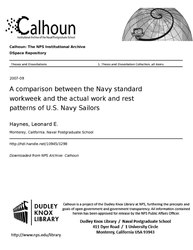File:A comparison between the Navy standard workweek and the actual work and rest patterns of U.S. Navy Sailors (IA acomparisonbetwe109453298).pdf

Original file (1,275 × 1,650 pixels, file size: 2.77 MB, MIME type: application/pdf, 128 pages)
Captions
Captions
Summary[edit]
| A comparison between the Navy standard workweek and the actual work and rest patterns of U.S. Navy Sailors
( |
||
|---|---|---|
| Author |
Haynes, Leonard E. |
|
| Title |
A comparison between the Navy standard workweek and the actual work and rest patterns of U.S. Navy Sailors |
|
| Publisher |
Monterey, California. Naval Postgraduate School |
|
| Description |
The demands placed upon the United States Navy are greater now than ever before. As ships become more versatile, Sailors must become proficient in many warfare areas while maintaining operational readiness. The primary manning tool used by the United States Navy to determine manpower requirements is the Navy Standard Workweek. This research seeks to determine if the Navy Standard Workweek accurately reflects the activities of deployed Sailors and determine their work and rest patterns. Each Sailor completed surveys detailing tasks in which they were engaged. Survey data were compared to the Navy Standard Workweek. Individual Sailors aboard USS CHUNG-HOON (DDG-93) wore Wrist Activity Monitors to collect actigraphy data. Actigraphy data were analyzed using the Fatigue Avoidance Scheduling Tool (FAST), which uses the Sleep, Activity, Fatigue and Task Effectiveness (SAFTE) Model, to predict the waking effectiveness level of each Sailor. The results showed that the Navy Standard Workweek does not accurately reflect the daily activities of Sailors. More importantly, based on FAST results, most Sailors had predicted effectiveness levels lower than the predicted effectiveness level of the Navy Standard Workweek Model. It is recommended that the Navy Standard Workweek be revised to more accurately reflect requirements of Sailors in different departments. Subjects: Sailors; Circadian rhythms; Fatigue; Sleep; Actigraphy; Physiology |
|
| Language | English | |
| Publication date | September 2007 | |
| Current location |
IA Collections: navalpostgraduateschoollibrary; fedlink |
|
| Accession number |
acomparisonbetwe109453298 |
|
| Source | ||
| Permission (Reusing this file) |
Approved for public release, distribution unlimited | |
Licensing[edit]
| Public domainPublic domainfalsefalse |
This work is in the public domain in the United States because it is a work prepared by an officer or employee of the United States Government as part of that person’s official duties under the terms of Title 17, Chapter 1, Section 105 of the US Code.
Note: This only applies to original works of the Federal Government and not to the work of any individual U.S. state, territory, commonwealth, county, municipality, or any other subdivision. This template also does not apply to postage stamp designs published by the United States Postal Service since 1978. (See § 313.6(C)(1) of Compendium of U.S. Copyright Office Practices). It also does not apply to certain US coins; see The US Mint Terms of Use.
|
 | |
| This file has been identified as being free of known restrictions under copyright law, including all related and neighboring rights. | ||
https://creativecommons.org/publicdomain/mark/1.0/PDMCreative Commons Public Domain Mark 1.0falsefalse
File history
Click on a date/time to view the file as it appeared at that time.
| Date/Time | Thumbnail | Dimensions | User | Comment | |
|---|---|---|---|---|---|
| current | 21:33, 13 July 2020 |  | 1,275 × 1,650, 128 pages (2.77 MB) | Fæ (talk | contribs) | FEDLINK - United States Federal Collection acomparisonbetwe109453298 (User talk:Fæ/IA books#Fork8) (batch 1993-2020 #5209) |
You cannot overwrite this file.
File usage on Commons
The following page uses this file:
Metadata
This file contains additional information such as Exif metadata which may have been added by the digital camera, scanner, or software program used to create or digitize it. If the file has been modified from its original state, some details such as the timestamp may not fully reflect those of the original file. The timestamp is only as accurate as the clock in the camera, and it may be completely wrong.
| Short title |
|
|---|---|
| Author | silva |
| Software used | PScript5.dll Version 5.2 |
| File change date and time | 03:11, 15 October 2007 |
| Date and time of digitizing | 09:01, 17 September 2007 |
| Date metadata was last modified | 03:11, 15 October 2007 |
| Conversion program | Acrobat Distiller 6.0.1 (Windows) |
| Encrypted | no |
| Page size | 612 x 792 pts (letter) |
| Version of PDF format | 1.4 |

